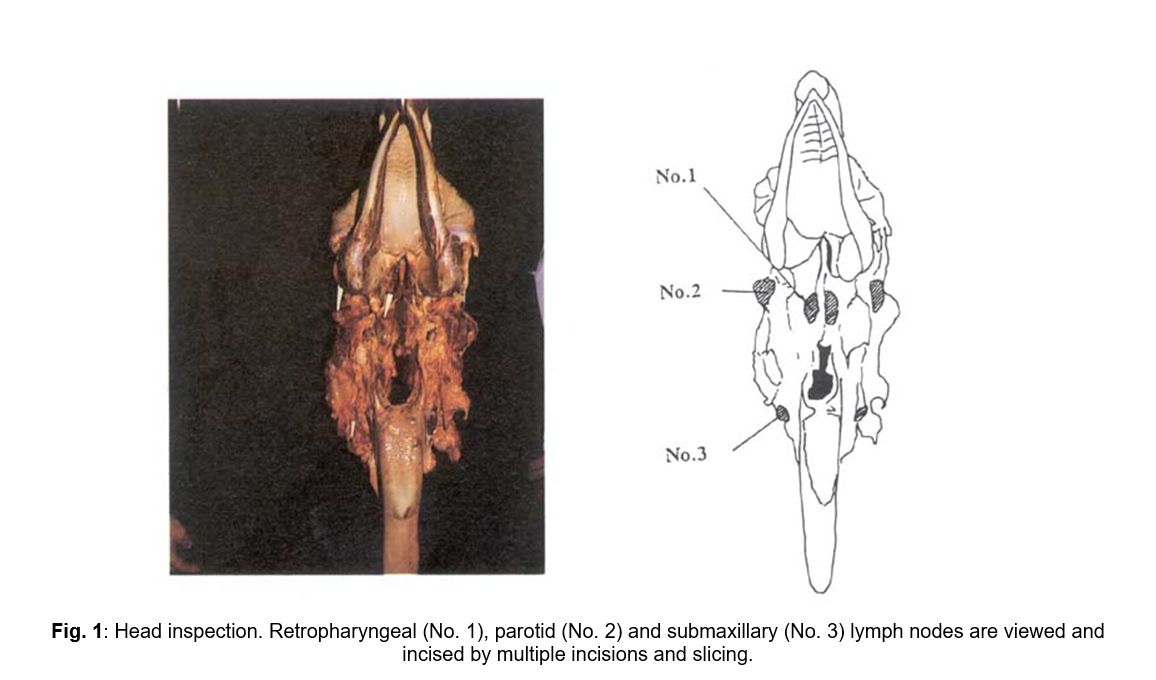
Post-mortem examination of food animals
"last update: 9 Oct 2024"
- Post-mortem examination of cattle
A-Obligatory (Routine post-mortem)
I- Carcass inspection:
Before proceeding the post-mortem inspection, particular attention should be paid the following
1. The state of nutrition:
a) Well fleshed.
b) Poor.
c) Emaciated.
2. Any evidence of injuries, bruising, haemorrhage, abnormal colour, abscess and fractures.
3. Local or general oedema.
4. Efficiency of bleeding.
5. Any signs of deformities of bone and joint.
6. Age and sex of the animal.
7. Abnormal odour.
a) Sexual odour (male sheep, goat, pig).
b) Uraemia.
8. Condition of pleura and peritoneum.
9. Lymphatic system affections:
a) Leukosis.
b) Caseous lymphadenitis.
II- Blood:
During the process of bleeding, the inspector should observe and examine the evacuated blood, especially in cases of emergency slaughter.
1. Clotting ability (fails to colt in case of septicaemia and toxaemia).
2. Colour:
a) Pale in anaemia
b) Reddish white in leukaemia.
c) Dark red in fever.
III- Head: Examination of the head includes:
1. Teeth for aging of the animal.
2. Lips and gums for presence of ulcers.
a. F.M.D.
b. Stomatitis
c. Actimomycosis.
d. Cattle plague.
3. Tongue examined for:
a. Actinobacillosis.
b. F.M.D.
c. Cysticerci (making of longitudinal incision along its middle line).
4. Examination of external and internal masseter muscles for cysticerci by made incision parallel with lower jaw.
5. Incisions of lymph node For tuberculosis, actinobacillosis and abscesses
a. Retropharyngeal.
b. Sub maxillary.
c. Parotid.
6. Mucous membranes of eyes for:
a. Jaundice (yellowish).
b. Fever (congested).


IV- Pluck
(lungs, trachea, oesophagus). · Sarcosporidia
“Buffaloes”. a.
Inspection: · Pneumonia. · Melanosis. b.
Palpation: · Hydatid cyst. · Abscess. c.
Incision: · Left bronchial lymph
node and mediastinal Lymph node for T.B. · Lung tissue (exposed by
deep incision from the base to the apex of each lung, trachea& main
branches of the bronchi) for: i. Parasites. ii. T.B. iii. C.B.P.P. iv. Abscess.


V- Heart: 1.
Pericardium: a)
Traumatic pericarditis. b)
T.B. c)
Haemorrhages. 2.
Epicardium: a)
Petechial hemorrhages. 3.
Myocardium: a)
Cysticerci. b)
Hydatid cyst and
Linguatulae. 4.
Endocardium: a)
Petechial haemorrhages. b)
Endocarditis,
Vegetative endocarditis (Chronic swine erysipelas).
VI- Liver 1.
Inspection: a.
Focal necrosis. b.
Telangiectesis. c.
Degeneration (Fatty
change). 2.
Palpation: a.
Abscess. b.
Hydatid cyst. 3.
Incision at
the base of the caudate lobe to examine the bile ducts. a.
Liver tissue: b.
Cirrhosis. c.
Anthrax. 4.
Hepatic
lymph node: a) T.B.
VII- Spleen: 1. Inspection: · Enlargement: · Blood
parasites. · Anthrax. · Leukemia. 2. Palpation: · Tumour. · Hydatid
cyst.
IX- Kidney 1. Inspection: · Renal
fat gelatinous in emaciated carcass. · Kidney
capsule for petechial haemorrhage in septicaemia. 2.
Palpation: · Inflammation. · Tumours. . Cysts. 3. Incision: · Kidney tissue: -
Emboli. -
Pyelonephritis. · Renal lymph node for
“T.B. IX- Udder: 1.
Inspection for
mastitis. 2.
Palpation for
abscess. 3.
Incision by along and
multiple deep incisions in the udder tissue and supra- mammary lymph node for
T.B. 4.
In Brucellosis reactors
the udder is removed intact without incision and without handling. X- Testes: 1.
Inspection for
orchitis. 2.
Incision of superficial
inguinal lymph node for T.B. XI- Stomach, intestine and
omentum 1. Inspection: · Parasites. · Enteritis. · Tumours. 2. Incisions in
mesenteric lymph node for: · T.B. · Linguatula.

XII- Uterus · The
uterus should be inspected, palpated, if necessary, incised, care being taken
to prevent contamination of the carcass. In Brucellosis reactors the uterus
must not be incised or handled. · Endometeritis XIII- Feet · F.M.D. · Foot
rot.
